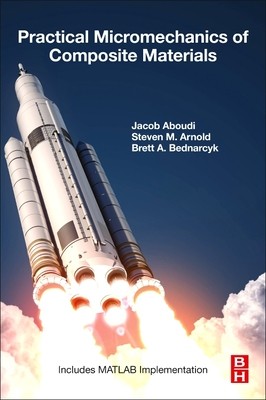
- We will send in 10–14 business days.
- Author: Jacob Aboudi
- Publisher: Butterworth-Heinemann
- ISBN-10: 0128206373
- ISBN-13: 9780128206379
- Format: 15.2 x 22.9 x 2.2 cm, softcover
- Language: English
- SAVE -10% with code: EXTRA
Reviews
Description
Practical Micromechanics of Composite Materials provides an accessible treatment of micromechanical theories for the analysis and design of multi-phased composites. Written with both students and practitioners in mind and coupled with a fully functional MATLAB code to enable the solution of technologically relevant micromechanics problems, the book features an array of illustrative example problems and exercises highlighting key concepts and integrating the MATLAB code. The MATLAB scripts and functions empower readers to enhance and create new functionality tailored to their needs, and the book and code highly complement one another. The book presents classical lamination theory and then proceeds to describe how to obtain effective anisotropic properties of a unidirectional composite (ply) via micromechanics and multiscale analysis. Calculation of local fields via mechanical and thermal strain concentration tensors is presented in a unified way across several micromechanics theories. The importance of these local fields is demonstrated through the determination of consistent Margins of Safety (MoS) and failure envelopes for thermal and mechanical loading. Finally, micromechanics-based multiscale progressive damage is discussed and implemented in the accompanying MATLAB code.
EXTRA 10 % discount with code: EXTRA
The promotion ends in 19d.20:47:34
The discount code is valid when purchasing from 10 €. Discounts do not stack.
- Author: Jacob Aboudi
- Publisher: Butterworth-Heinemann
- ISBN-10: 0128206373
- ISBN-13: 9780128206379
- Format: 15.2 x 22.9 x 2.2 cm, softcover
- Language: English English
Practical Micromechanics of Composite Materials provides an accessible treatment of micromechanical theories for the analysis and design of multi-phased composites. Written with both students and practitioners in mind and coupled with a fully functional MATLAB code to enable the solution of technologically relevant micromechanics problems, the book features an array of illustrative example problems and exercises highlighting key concepts and integrating the MATLAB code. The MATLAB scripts and functions empower readers to enhance and create new functionality tailored to their needs, and the book and code highly complement one another. The book presents classical lamination theory and then proceeds to describe how to obtain effective anisotropic properties of a unidirectional composite (ply) via micromechanics and multiscale analysis. Calculation of local fields via mechanical and thermal strain concentration tensors is presented in a unified way across several micromechanics theories. The importance of these local fields is demonstrated through the determination of consistent Margins of Safety (MoS) and failure envelopes for thermal and mechanical loading. Finally, micromechanics-based multiscale progressive damage is discussed and implemented in the accompanying MATLAB code.


Reviews